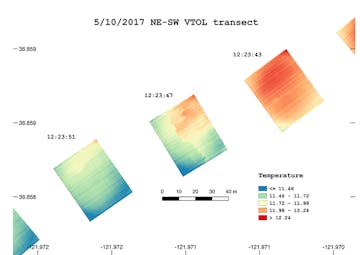Many critical ocean processes occur, or are exposed at, the interface of the air and the ocean surface. Aerial sensing platforms can provide safe, inexpensive methods to observe these phenomena in great detail, with regularity, and on short notice. To advance access to this area, without adding more ships to the MBARI fleet, a team of scientists and engineers is perfecting how to use the rapidly developing technology of unmanned aerial vehicles (UAVs).
UAVs will enable a wide variety of repeatable and low-cost science applications including repeatable surveys of animal counts and locations, thermal and color ocean-front tracking, harmful algal bloom detection and monitoring, kelp forest health, predation behavior, marine debris, distressed animal detection, and lost-vehicle recovery. This technology will also document MBARI at-sea operations for educational and outreach purposes.


